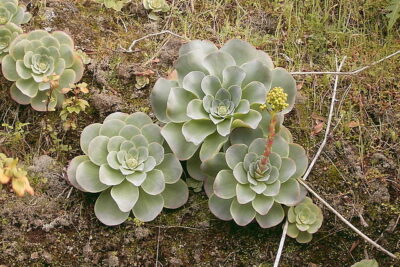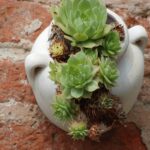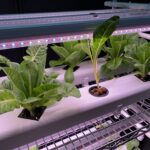
Can You Keep Succulents Indoors Year-Round?

Succulents have become increasingly popular in recent years due to their unique shapes and vibrant colors. These plants are known for their ability to store water in their leaves, stems, and roots, making them highly resilient and low-maintenance. While many people enjoy growing succulents outdoors, there is often a question of whether they can be kept indoors year-round.
We will explore the possibility of keeping succulents indoors throughout the year. We will discuss the factors to consider when choosing to grow succulents indoors, such as lighting, temperature, and humidity. Additionally, we will provide tips and recommendations on how to care for indoor succulents, including watering schedules, soil requirements, and potential challenges to watch out for. By the end of this article, you will have a better understanding of whether it is feasible to keep succulents as indoor plants and how to ensure their health and longevity in an indoor environment.
- Yes, you can keep succulents indoors year-round
- Provide them with enough sunlight
- Place them near a sunny window
- Use grow lights if sunlight is limited
- Water them sparingly
- Allow the soil to dry out between waterings
- Do not overwater, as this can lead to root rot
- Use well-draining soil
- Avoid using regular potting soil
- Fertilize them occasionally
- Use a balanced succulent fertilizer
- Keep the temperature between 60-80°F (15-27°C)
- Protect them from extreme temperatures and drafts
- Prune them to maintain their shape
- Remove dead or yellow leaves regularly
- Keep an eye out for pests
- Treat pest infestations promptly
- Rotate them occasionally to ensure even growth
- Repot them when they outgrow their container
- Use a larger pot with good drainage
- Enjoy the beauty and variety of your indoor succulent collection
- Frequently Asked Questions
Yes, you can keep succulents indoors year-round
If you love succulents but don't have access to an outdoor garden or live in a climate that isn't suitable for these desert plants, fear not! You can absolutely keep succulents indoors year-round and enjoy their unique beauty and low-maintenance nature.
Succulents are well-known for their ability to store water in their leaves, stems, and roots. This adaptation allows them to thrive in arid environments, making them perfect for indoor spaces with dry air conditions.
When it comes to keeping succulents indoors, there are a few key factors to consider:
1. Lighting
Succulents love sunlight. To keep them healthy and happy indoors, place them in a spot that receives bright, indirect light for at least six hours a day. South-facing windows are usually the best choice, but east or west-facing windows can also work well. If your indoor space lacks natural light, you can supplement it with artificial grow lights.
 Indoor vs Outdoor: Ideal Growing Environments for Succulents
Indoor vs Outdoor: Ideal Growing Environments for Succulents2. Watering
One of the biggest mistakes people make with succulents is overwatering. These plants are adapted to survive in dry conditions, so they don't need frequent watering. Allow the soil to dry out completely between waterings, and make sure to use a well-draining potting mix to prevent waterlogged roots.
3. Temperature and Humidity
Succulents prefer temperatures between 60°F and 80°F (15°C and 27°C). They can tolerate slightly cooler or warmer temperatures, but extreme fluctuations can stress them. In terms of humidity, most succulents can handle low-humidity environments, which makes them suitable for indoor conditions.
4. Potting and Fertilizing
Choose a pot with drainage holes to ensure excess water can escape. Succulents thrive in well-draining soil, so use a specialized succulent or cactus mix. Fertilize sparingly, as succulents are not heavy feeders. A balanced, water-soluble fertilizer diluted to half strength once a month during the growing season should be sufficient.
By following these guidelines and providing your indoor succulents with the right conditions, you can enjoy their beauty and uniqueness year-round. Remember to observe your plants closely and adjust care as needed. With a little attention, your indoor succulents will thrive and bring a touch of the desert into your home.
Provide them with enough sunlight
Succulents are known for their ability to thrive in dry and arid conditions, making them a popular choice for indoor plants. However, it's important to remember that even these hardy plants need a sufficient amount of sunlight to survive indoors year-round.
When keeping succulents indoors, it's best to place them in a spot where they can receive at least 6 hours of bright, indirect sunlight each day. This can be achieved by placing them near a south-facing window or using artificial grow lights.
 Optimal Indoor Lighting for Succulents: Sunlight or Not?
Optimal Indoor Lighting for Succulents: Sunlight or Not?Grow lights are a great alternative for those who don't have access to enough natural sunlight. Opt for full-spectrum grow lights that mimic the natural light spectrum, as they provide the necessary light wavelengths for succulent growth.
Keep in mind that succulents can get sunburned if exposed to direct sunlight for too long. If you notice their leaves turning brown or yellow, it may be a sign that they're getting too much sunlight. In such cases, consider moving them to a slightly shadier spot.
Regularly rotating your succulents is also beneficial, as it ensures that all sides of the plant receive equal sunlight exposure. This prevents the plant from growing lopsided or leaning towards the light source.
Place them near a sunny window
One of the most important factors to consider when keeping succulents indoors year-round is their exposure to sunlight. Succulents thrive in bright, indirect light, so placing them near a sunny window is essential. Ideally, choose a south-facing window as it receives the most sunlight throughout the day. However, east or west-facing windows can also work if they provide sufficient light.
It's crucial to note that succulents need at least 6 hours of sunlight per day to maintain their health and vibrant colors. If your home doesn't have enough natural light, you can supplement it with artificial lighting. Using grow lights designed for plants can help provide the necessary light intensity and duration for your succulents.
When placing your succulents near a window, ensure they are not in direct contact with the glass, as it can become too hot and scorch the leaves. Use sheer curtains or blinds to filter the intensity of sunlight and prevent any potential damage.
 Can Succulents Thrive Indoors Without Sunlight?
Can Succulents Thrive Indoors Without Sunlight?Remember to rotate your succulents regularly to ensure even growth and prevent them from leaning towards the light source. This will help maintain their symmetry and prevent any lopsided growth.
Additionally, if you notice your succulents stretching or becoming leggy, it may indicate that they are not receiving enough light. In such cases, consider moving them closer to a brighter window or adjusting the artificial lighting.
Use grow lights if sunlight is limited
If you're planning to keep your succulents indoors year-round but don't have access to direct sunlight, don't fret! You can still provide your beloved plants with the light they need by using grow lights.
Grow lights are artificial light sources specifically designed to mimic the sun's rays and provide plants with the necessary light for growth. These lights emit a spectrum of light that closely resembles natural sunlight, making them an excellent alternative for indoor gardening.
When choosing grow lights for your succulents, opt for full-spectrum LED lights. These lights are energy-efficient, long-lasting, and emit the right balance of blue and red light, which is essential for succulent growth.
Ensure that the grow lights are placed at the appropriate distance from your succulents. Typically, a distance of 6-12 inches above the plants is recommended, but it may vary depending on the specific type of grow light you're using. Be sure to check the manufacturer's instructions for the optimal distance.
Additionally, it's crucial to provide your succulents with an adequate light duration. Most succulents require around 12-14 hours of light per day. You can use a timer to automate the lighting schedule and ensure your plants receive consistent light exposure.
 Can Succulents Flourish with Grow Lights?
Can Succulents Flourish with Grow Lights?Remember that while grow lights can effectively provide the light your succulents need, they should not be the sole source of light. If possible, place your succulents near a window or in a well-lit room to supplement the artificial light.
By utilizing grow lights and ensuring your succulents receive the right amount of light, you can successfully keep them indoors year-round and enjoy their beauty and resilience throughout the seasons.
Water them sparingly
When it comes to keeping succulents indoors year-round, one of the most important factors to consider is how often to water them. Succulents are known for their ability to store water in their leaves and stems, which allows them to survive in arid conditions. However, this also means that they are prone to rot if overwatered.
To prevent overwatering, it is crucial to water your succulents sparingly. A general rule of thumb is to wait until the soil is completely dry before watering again. You can test the moisture level by sticking your finger about an inch into the soil. If it feels dry, it's time to water your succulents.
It's important to note that succulents have different watering needs depending on the season and environmental conditions. During the summer months when they are actively growing, they may require more frequent watering. In contrast, during the winter months when they are in a dormant state, they will need less water. Adjust your watering schedule accordingly.
When watering your succulents, remember to do it thoroughly but avoid soaking the soil. Use a watering can with a narrow spout to direct the water directly to the base of the plant, avoiding the leaves. Allow the excess water to drain out completely to prevent waterlogged roots.
Remember, it's better to underwater succulents than to overwater them. They are more tolerant of drought than excessive moisture. By providing them with just the right amount of water, you can help your succulents thrive indoors year-round.
 Can Mother of Thousands Succulents Thrive Indoors?
Can Mother of Thousands Succulents Thrive Indoors?Allow the soil to dry out between waterings
When it comes to keeping succulents indoors year-round, one essential factor to consider is proper watering. Succulents are known for their ability to store water in their leaves and stems, making them more tolerant to drought conditions. However, this doesn't mean they can survive without any water at all.
It is crucial to allow the soil to dry out between waterings. Overwatering can lead to root rot and other diseases, which can be detrimental to the health of your succulents. To determine when to water your plants, check the moisture level of the soil by inserting your finger about an inch deep. If the soil feels dry, it's time to water. If it's still damp, hold off on watering for a few more days.
Remember, succulents are adapted to arid environments, so they prefer a drier soil compared to other houseplants. Over time, you'll develop a watering routine that suits your specific succulent varieties and the conditions in your home.
Here are some watering tips to keep in mind:
- Use a well-draining soil mix specifically formulated for succulents.
- Water the soil directly, avoiding getting water on the leaves or stems as this can lead to rot.
- Water deeply until the excess water drains out from the bottom of the pot.
- During the winter months, when succulents enter a period of dormancy, reduce watering frequency.
By following these watering guidelines, you can ensure that your indoor succulents thrive and remain healthy throughout the year.
Do not overwater, as this can lead to root rot
When it comes to keeping succulents indoors year-round, one of the most important factors to consider is proper watering. Succulents are known for their ability to store water in their leaves, stems, and roots, allowing them to thrive in arid conditions. However, this also means that they are susceptible to root rot if overwatered.
To prevent root rot, it is crucial to avoid overwatering your indoor succulents. These plants have different water requirements compared to traditional houseplants. Instead of watering on a regular schedule, it is best to let the soil dry out completely between waterings. This usually means watering your succulents every 1-2 weeks, depending on the specific variety and environmental conditions.
 Growing Succulents on Trees: A Unique Outdoor Garden Idea
Growing Succulents on Trees: A Unique Outdoor Garden IdeaWhen watering your succulents, it is important to provide a thorough soak. This means watering until water starts to drain out of the bottom of the pot. However, avoid letting your succulents sit in standing water, as this can also contribute to root rot. Make sure to use a well-draining potting mix specifically formulated for succulents, as this will help prevent water from pooling around the roots.
Additionally, it is important to adjust your watering routine based on the season. During the winter months, when succulents are in a dormant phase, they require less water. You can reduce the frequency of watering to every 3-4 weeks to avoid overwatering during this time.
When keeping succulents indoors year-round, it is crucial to be mindful of proper watering practices. Avoid overwatering to prevent root rot, water thoroughly but allow the soil to dry out completely between waterings, and adjust watering frequency based on the season. By following these guidelines, you can successfully keep your succulents healthy and thriving indoors.
Use well-draining soil
When it comes to keeping succulents indoors year-round, one of the most crucial factors to consider is the type of soil you use. Succulents thrive in well-draining soil that allows excess water to flow through and prevent root rot.
It is recommended to use a mixture of potting soil, perlite, and sand to create a well-draining medium for your indoor succulents. This combination helps to mimic the natural habitat of succulents, where they grow in arid and sandy conditions.
Tip: Avoid using regular garden soil or heavy potting mixes, as they tend to retain moisture for longer periods, which can lead to overwatering and ultimately harm your succulents.
 Easy Tips for Indoor Succulent Care: A Guide to Succulent Success!
Easy Tips for Indoor Succulent Care: A Guide to Succulent Success!Avoid using regular potting soil
When it comes to keeping succulents indoors year-round, one of the most important factors to consider is the type of soil you use. Regular potting soil, which is typically used for a variety of houseplants, is not suitable for succulents.
Succulents thrive in well-draining soil that allows excess water to flow out easily. Regular potting soil tends to retain moisture, which can lead to root rot and other issues for succulents.
Instead, opt for a specialized succulent or cactus soil mix, which is specifically formulated to provide the ideal growing conditions for these plants. These mixes are usually made up of a combination of materials such as sand, perlite, and peat moss, which promote better drainage and aeration.
It's important to note that succulents have shallow root systems, so using a shallow pot with drainage holes is also essential. This allows excess water to escape and prevents the roots from sitting in soggy soil.
Remember: Succulents prefer to be slightly underwatered than overwatered. They are adapted to survive in arid environments and can store water in their leaves and stems. Overwatering can lead to root rot and ultimately kill the plant.
Fertilize them occasionally
Succulents are known for their ability to thrive in dry and arid conditions, making them a popular choice for indoor gardening. However, many people wonder if succulents can be kept indoors year-round. The answer is yes, but there are a few important factors to consider.
 Can Succulents Survive Outdoors All Year?
Can Succulents Survive Outdoors All Year?Lighting: Succulents need plenty of sunlight to thrive, so it's important to provide them with adequate lighting if you're keeping them indoors. Place your succulents near a sunny window or invest in grow lights to ensure they get the light they need.
Temperature: Most succulents prefer warm temperatures, so try to keep your indoor environment between 60-85°F (15-29°C). Avoid placing them near drafty windows or in areas with extreme temperature fluctuations.
Watering: One common mistake people make with succulents is overwatering. These plants are adapted to store water in their leaves, so they can go longer periods without being watered. It's best to water your succulents only when the soil is completely dry, and be sure to use a well-draining soil mix.
Fertilizing: While succulents don't require frequent fertilization, it's still important to provide them with some nutrients. Use a balanced fertilizer and apply it sparingly, following the instructions on the packaging. Over-fertilizing can lead to excessive growth and weak plants.
Proper drainage: Succulents dislike sitting in soggy soil, as it can lead to root rot. Ensure that your pots have drainage holes to allow excess water to escape. Additionally, use a well-draining soil mix that allows water to pass through easily.
Choosing the right succulents: Some succulents are better suited for indoor growing than others. Look for varieties that are known to thrive indoors, such as Echeveria, Haworthia, or Aloe vera. These plants have adapted to lower light conditions and are more tolerant of indoor environments.
By following these guidelines, you can successfully keep your succulents indoors year-round. With proper care, these fascinating plants will continue to bring beauty and greenery to your indoor space.
 Can a Star Flower Succulent Survive and Thrive Indoors?
Can a Star Flower Succulent Survive and Thrive Indoors?Use a balanced succulent fertilizer
Succulents are known for their ability to thrive in a variety of environments, including indoors. However, to keep your succulents healthy and happy indoors year-round, it is important to provide them with the right nutrients. One way to do this is by using a balanced succulent fertilizer.
When choosing a succulent fertilizer, it is important to look for one that is specifically formulated for these types of plants. Succulents have unique nutritional needs, and using a fertilizer that is not designed for them can lead to nutrient deficiencies or even damage to the plants.
A balanced succulent fertilizer typically contains a mix of essential nutrients, including nitrogen, phosphorus, and potassium. These nutrients are important for promoting healthy growth, vibrant colors, and strong roots in succulents. Additionally, some fertilizers may also contain trace elements, such as iron and magnesium, which are beneficial for overall plant health.
It is recommended to follow the instructions on the fertilizer packaging to determine the correct dosage and frequency of application. Over-fertilizing succulents can be just as harmful as under-fertilizing, so it is important to find the right balance.
When applying the fertilizer, it is best to dilute it with water according to the instructions, as succulents prefer a more diluted solution. This helps to prevent the buildup of salts and minerals in the soil, which can be damaging to the plants over time.
Regularly fertilizing your indoor succulents can provide them with the necessary nutrients to thrive and maintain their health throughout the year. However, it is important to remember that fertilizing is just one aspect of succulent care. Providing adequate sunlight, proper watering, and well-draining soil are also crucial for their overall well-being.
 Can Succulents Survive Outdoors in Winter?
Can Succulents Survive Outdoors in Winter?Keep the temperature between 60-80°F (15-27°C)
When it comes to keeping succulents indoors year-round, maintaining the right temperature is crucial. Succulents thrive in a temperature range of 60-80°F (15-27°C). This means that you need to ensure that your indoor environment stays within this temperature range consistently.
Succulents are adapted to survive in arid and hot climates, so they prefer warmer temperatures. However, they can also tolerate cooler temperatures as long as they are not exposed to frost or extreme cold. If the temperature drops below 60°F (15°C), it's important to take extra precautions to protect your succulents.
During the winter months, when indoor heating can cause the air to become dry, you may need to consider using a humidifier or placing a tray filled with water near your succulents to increase the humidity around them. This can help prevent the leaves from drying out and keep your succulents healthy.
On the other hand, if the temperature in your home exceeds 80°F (27°C), you should provide your succulents with some shade or move them to a cooler spot. Direct sunlight combined with high temperatures can cause the leaves to burn or become dehydrated.
Remember to regularly monitor the temperature in your home and make adjustments as needed to create a favorable environment for your succulents to thrive indoors year-round.
Protect them from extreme temperatures and drafts
Succulents are known for their ability to thrive in dry and arid conditions, making them a popular choice for indoor plants. However, it is important to remember that while succulents can survive indoors year-round, they still require a certain level of care to ensure their well-being.
One of the key factors to consider when keeping succulents indoors is protecting them from extreme temperatures and drafts. While succulents can tolerate a wide range of temperatures, they generally prefer temperatures between 60°F and 80°F (15°C to 27°C).
To keep your indoor succulents happy, it's important to place them in a location where they won't be exposed to extreme heat or cold. Avoid placing them near heating vents, radiators, or air conditioning units, as these can create temperature fluctuations that can stress the plants.
In addition to temperature, succulents are also sensitive to drafts. Cold drafts can be particularly harmful, causing their leaves to become damaged or even leading to rot. Be cautious of placing succulents near windows or doors that are frequently opened, especially during the winter months.
When it comes to protecting your succulents from drafts, you can also consider using indoor fans or humidifiers to improve air circulation without subjecting them to direct drafts. This can help maintain a more consistent and suitable environment for your indoor succulents.
Remember, succulents are adaptable plants, but they still need a stable and comfortable environment to thrive indoors year-round. By taking the necessary precautions to protect them from extreme temperatures and drafts, you can enjoy the beauty of these unique plants in your home all year long.
Prune them to maintain their shape
Succulents are known for their unique shapes and forms, which is why it's important to prune them regularly to keep them looking their best. Pruning not only helps maintain their shape but also encourages new growth and prevents the plant from becoming too leggy or unruly.
When pruning succulents, it's important to use sharp, clean tools to avoid damaging the plant. Start by removing any dead or damaged leaves or stems. This will not only improve the plant's appearance but also prevent the spread of diseases or pests.
Next, you can trim back any overgrown or elongated stems to maintain a compact and tidy shape. Use your fingers or a clean pair of pruning shears to carefully remove the excess growth. Be sure to cut just above a leaf node or joint to encourage new growth.
Additionally, if you notice any branches or stems that are stretching towards the light source, you can trim them back to encourage the plant to grow in a more balanced and symmetrical manner. This will help prevent the succulent from becoming top-heavy or leaning towards one side.
Remember, when pruning succulents, it's important to be mindful of the plant's natural growth patterns and not to remove too much foliage at once. Take your time and step back occasionally to assess the plant's overall shape and make adjustments as needed.
By regularly pruning your indoor succulents, you can maintain their shape, promote healthy growth, and ensure that they continue to thrive in your home year-round.
Remove dead or yellow leaves regularly
One important aspect of keeping succulents indoors year-round is to regularly remove dead or yellow leaves. These leaves not only detract from the overall appearance of your succulent, but they can also be a breeding ground for pests and diseases.
By removing these leaves, you not only improve the aesthetic appeal of your plant, but you also promote its overall health and vitality. Dead or yellow leaves can sap energy from the plant, diverting resources that could be better used for new growth.
To remove dead or yellow leaves, simply use your fingers or a pair of clean, sharp scissors. Gently tug or cut the leaf at the base where it meets the stem. Take care not to damage the healthy leaves or stem during this process.
It's important to note that not all succulents naturally shed their leaves. Some varieties, such as echeverias, may retain their lower leaves even as they grow. In these cases, it's best to leave the leaves intact unless they are obviously dead or yellow.
Regularly inspect your succulent for any signs of dead or yellow leaves and remove them promptly. This simple maintenance task will go a long way in keeping your indoor succulents healthy and thriving year-round.
Keep an eye out for pests
When keeping succulents indoors year-round, it is important to be vigilant about pests. Even though succulents are known for their resilience, they can still fall victim to pesky invaders. Some common pests that may infest your indoor succulents include mealybugs, scale insects, spider mites, and aphids.
To prevent and control pest infestations, regularly inspect your succulents for any signs of pests or damage. Look for sticky residue, discolored leaves, or tiny insects crawling on the plants. If you spot any signs of pests, take immediate action to prevent further damage.
One effective method to get rid of pests is to manually remove them using a cotton swab dipped in rubbing alcohol. Gently dab the affected areas to kill the pests and wipe away any residue. For more severe infestations, you can use a natural insecticidal soap or neem oil spray, following the instructions on the product label.
Additionally, it is crucial to isolate any infested plants to prevent the pests from spreading to your other succulents. Quarantine the affected plant in a separate area until you are confident that the infestation has been completely eradicated.
Remember, prevention is always better than cure. Regularly inspecting your succulents, maintaining proper hygiene, and providing them with optimal growing conditions will greatly reduce the risk of pest infestations.
Key points to remember:
- Inspect your succulents regularly for signs of pests.
- Manually remove pests using rubbing alcohol or use natural insecticidal soap.
- Isolate infested plants to prevent the spread of pests.
- Prevention is key to avoiding pest infestations.
Treat pest infestations promptly
Pests can be a common problem when growing succulents indoors. These tiny invaders, such as mealybugs, aphids, and spider mites, can quickly multiply and cause damage to your plants if left untreated.
It is important to regularly inspect your succulents for signs of pests. Look for any unusual spots, webbing, or cotton-like clusters on the leaves or stems. If you notice any of these signs, it is crucial to take immediate action to prevent the infestation from spreading.
One effective way to combat pest infestations is by using natural remedies or organic insecticides. Neem oil, for example, is a popular choice among succulent enthusiasts. It is a natural pesticide that can effectively control pests without harming your plants.
When treating your succulents for pests, make sure to follow the instructions on the product label carefully. Apply the remedy or insecticide evenly on the affected areas, ensuring that all pests are thoroughly covered. It is also advisable to repeat the treatment after a few days to eliminate any remaining pests or eggs.
Additionally, practicing good hygiene and plant care can help prevent pest infestations. Regularly clean your succulents' leaves with a damp cloth to remove dust and debris, as these can attract pests. Avoid overwatering, as excess moisture can create a favorable environment for pests to thrive.
By promptly treating pest infestations and implementing preventive measures, you can keep your succulents healthy and thriving indoors year-round.
Rotate them occasionally to ensure even growth
When it comes to keeping succulents indoors year-round, one important aspect to consider is their growth pattern. Succulents tend to grow towards the direction of the sunlight, which means that if they are placed near a window, they may start leaning towards it. To prevent this, it's a good idea to rotate your succulents occasionally.
Rotating your succulents helps promote even growth by exposing all sides of the plant to sunlight. This ensures that all parts of the succulent receive adequate light and prevents lopsided growth or leaning.
To rotate your succulents, simply turn the pots a quarter or half turn every few weeks. This will help distribute the sunlight evenly and encourage the succulent to grow in a more balanced manner. If you have a large collection of succulents, it may be helpful to create a rotation schedule to ensure that each plant gets its fair share of sunlight.
Remember to be gentle when rotating your succulents, as their leaves and stems are delicate and can break easily. Take care not to damage any roots or disturb the soil too much.
In addition to rotating your succulents, it's also beneficial to occasionally change their position within the room. This helps ensure that all sides of the succulent receive different lighting conditions, as natural light can vary throughout the day. By moving your succulents to different locations, you can provide them with a more diverse range of light exposure.
Repot them when they outgrow their container
One important aspect of keeping succulents indoors year-round is to regularly check if they have outgrown their containers. Succulents have a unique growth pattern, and their roots tend to expand and spread out quickly.
When you notice that your succulent's roots are becoming cramped and overcrowded in their current container, it's time to consider repotting them. Repotting allows the succulent to have more space for its roots to grow and absorb nutrients effectively.
When repotting your succulent, make sure to choose a container that is slightly larger than its current one. Opt for a well-draining potting mix specifically formulated for succulents. This type of soil mix ensures proper moisture retention while preventing excess water from causing root rot.
Before transferring your succulent to its new container, gently remove it from the old one, being careful not to damage the roots. Inspect the roots for any signs of rot or disease, and trim them if necessary. Place the succulent in the new pot and fill the remaining space with the potting mix, ensuring that the roots are adequately covered.
After repotting, it's essential to give your succulent some time to adjust to its new environment. Avoid watering it immediately after repotting, as this can lead to overwatering and root rot. Instead, wait for a few days before resuming your regular watering routine.
Remember to keep an eye on your succulent after repotting, ensuring that it receives the right amount of sunlight and water. With proper care and repotting when needed, your succulents can thrive and beautify your indoor space year-round.
Use a larger pot with good drainage
When it comes to keeping succulents indoors year-round, one important factor to consider is the pot you choose for them. Succulents have shallow root systems, so it's essential to provide them with a larger pot that allows for proper root growth.
Additionally, ensure that the pot has good drainage holes at the bottom. Succulents are highly susceptible to root rot if they sit in waterlogged soil for too long. By using a pot with good drainage, you can prevent excess water from accumulating and damaging the roots.
Remember to choose a pot that matches the aesthetic of your indoor space. There are various options available, from terracotta to ceramic pots, so you can find one that complements your home decor.
Tip: If you have a pot without drainage holes that you absolutely love, you can still use it for your succulents. Just make sure to create drainage by adding a layer of pebbles or activated charcoal at the bottom of the pot before adding the soil.
Enjoy the beauty and variety of your indoor succulent collection
Indoor succulents have become increasingly popular, and for good reason. These versatile plants come in a wide array of shapes, sizes, and colors, making them a perfect addition to any indoor space. But can you keep succulents indoors year-round? The answer is yes, with the right care and attention.
Understanding the needs of indoor succulents
Succulents are known for their ability to thrive in arid conditions, which is why they are often associated with desert landscapes. However, this doesn't mean that they can't be kept indoors. In fact, many succulent varieties are well-suited to indoor environments, as long as their basic needs are met.
One of the most important factors to consider when caring for indoor succulents is lighting. Succulents typically require bright, indirect light to thrive. Placing them near a south-facing window or using grow lights can help provide them with the necessary light levels. However, it's important to avoid direct sunlight, as this can scorch the leaves and cause damage to the plants.
Another crucial aspect of succulent care is watering. Unlike other houseplants, succulents have adapted to store water in their leaves, stems, or roots. As a result, they are more prone to overwatering than underwatering. It's essential to allow the soil to dry out completely between waterings. A well-draining soil mix and a pot with drainage holes can help prevent waterlogged roots and potential rot.
Creating the ideal environment for indoor succulents
In addition to proper lighting and watering, there are a few more factors to consider when creating the ideal environment for your indoor succulents.
- Temperature: Succulents generally prefer temperatures between 60-80°F (15-27°C). Avoid placing them near drafty windows or in areas with extreme temperature fluctuations.
- Humidity: Succulents thrive in low humidity environments, similar to their natural habitat. If your indoor space is particularly humid, you can use a dehumidifier or a fan to increase air circulation.
- Container: Choosing the right container is important for succulent care. Opt for a pot with drainage holes to prevent water accumulation, and use a well-draining soil mix specifically formulated for succulents.
Choosing the right succulents for indoor growing
While many succulents can be grown indoors, some varieties are better suited to indoor conditions than others. Here are a few popular indoor succulents:
- Echeveria: These rosette-shaped succulents come in a variety of colors and are known for their stunning foliage.
- Haworthia: These small succulents have distinctive, patterned leaves and are well-suited to indoor environments.
- Crassula: Also known as jade plants, crassulas are easy to care for and can thrive indoors with proper lighting.
By understanding the needs of indoor succulents and providing them with the right environment, you can enjoy the beauty and variety of these unique plants year-round.
Frequently Asked Questions
1. Can You Keep Succulents Indoors Year-Round?
Yes, you can keep succulents indoors year-round as long as they receive enough sunlight and proper care.
2. How often should I water my succulents?
Succulents should be watered sparingly, allowing the soil to completely dry out between waterings. Generally, once every 1-2 weeks is sufficient.
3. Do succulents need direct sunlight?
Yes, succulents thrive in bright light and need at least a few hours of direct sunlight each day to maintain their health and vibrant colors.
4. Can I propagate succulents from leaves?
Yes, many succulents can be propagated from leaves. Simply place the leaves on well-draining soil, mist occasionally, and wait for new roots and baby plants to form.
If you want to read more articles similar to Can You Keep Succulents Indoors Year-Round?, you can visit the Indoor and Outdoor Care category.






You Must Read